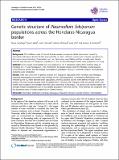Por favor, use este identificador para citar o enlazar a este item:
http://hdl.handle.net/10261/95016COMPARTIR / EXPORTAR:
 SHARE
BASE SHARE
BASE
|
|
| Visualizar otros formatos: MARC | Dublin Core | RDF | ORE | MODS | METS | DIDL | DATACITE | |

| Título: | Genetic structure of Plasmodium falciparum populations across the Honduras-Nicaragua border |
Autor: | Larrañaga, Nerea; Mejía, Rosa E.; Hormaza Urroz, José Ignacio CSIC ORCID ; Montoya, Alberto; Soto, Aida; Fontecha, Gustavo | Fecha de publicación: | 4-oct-2013 | Editor: | BioMed Central | Citación: | Malaria Journal 12(1) : 354- (2013) | Resumen: | Abstract Background The Caribbean coast of Central America remains an area of malaria transmission caused by Plasmodium falciparum despite the fact that morbidity has been reduced in recent years. Parasite populations in that region show interesting characteristics such as chloroquine susceptibility and low mortality rates. Genetic structure and diversity of P. falciparum populations in the Honduras-Nicaragua border were analysed in this study. Methods Seven neutral microsatellite loci were analysed in 110 P. falciparum isolates from endemic areas of Honduras (n = 77) and Nicaragua (n = 33), mostly from the border region called the Moskitia. Several analyses concerning the genetic diversity, linkage disequilibrium, population structure, molecular variance, and haplotype clustering were conducted. Results There was a low level of genetic diversity in P. falciparum populations from Honduras and Nicaragua. Expected heterozigosity (H e ) results were similarly low for both populations. A moderate differentiation was revealed by the FST index between both populations, and two putative clusters were defined through a structure analysis. The main cluster grouped most of samples from Honduras and Nicaragua, while the second cluster was smaller and included all the samples from the Siuna community in Nicaragua. This result could partially explain the stronger linkage disequilibrium (LD) in the parasite population from that country. These findings are congruent with the decreasing rates of malaria endemicity in Central America. | URI: | http://hdl.handle.net/10261/95016 | Identificadores: | http://dx.doi.org/10.1186/1475-2875-12-354 |
| Aparece en las colecciones: | (IHSM) Artículos |
Ficheros en este ítem:
| Fichero | Descripción | Tamaño | Formato | |
|---|---|---|---|---|
| 1475-2875-12-354.xml | 111,07 kB | XML | Visualizar/Abrir | |
| 1475-2875-12-354.pdf | 989,88 kB | Adobe PDF |  Visualizar/Abrir | |
| 1475-2875-12-354-S1.PDF | 56,35 kB | Adobe PDF |  Visualizar/Abrir |
CORE Recommender
Page view(s)
337
checked on 23-abr-2024
Download(s)
675
checked on 23-abr-2024
Google ScholarTM
Check
NOTA: Los ítems de Digital.CSIC están protegidos por copyright, con todos los derechos reservados, a menos que se indique lo contrario.
